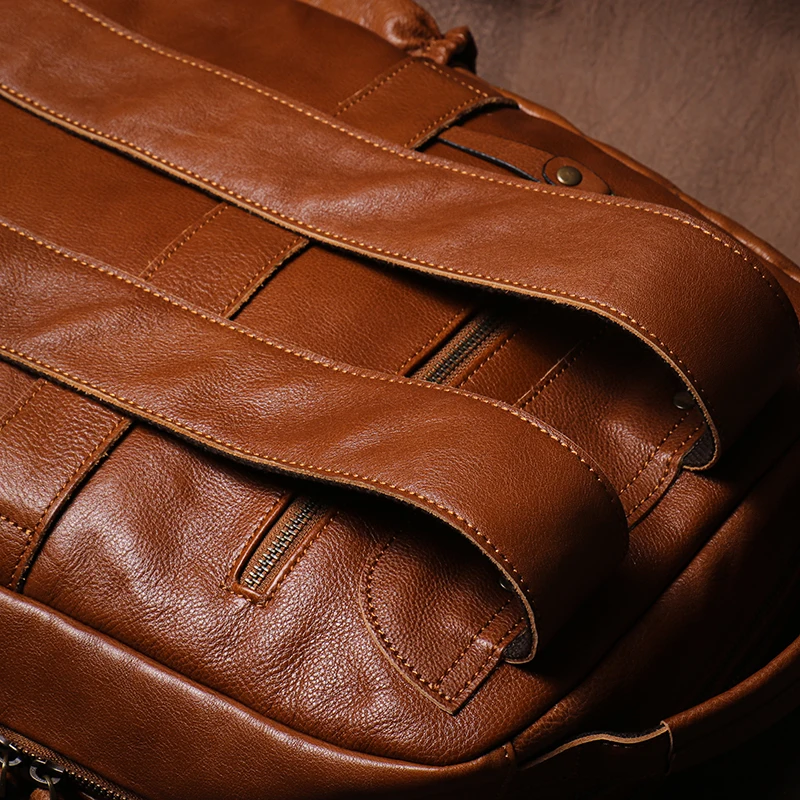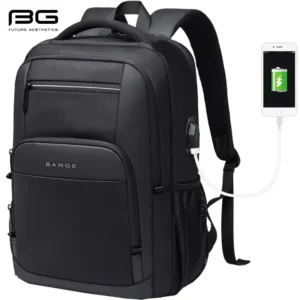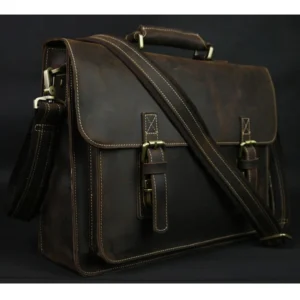Investing in a rugged leather backpack means choosing a companion that will journey with you for years to come. The right leather backpack combines timeless style with exceptional durability, becoming more beautiful with age as it develops a unique character. This guide will walk you through everything you need to know to select a leather backpack that truly stands the test of time.
Understanding Leather Quality: The Foundation of Durability
The quality of leather used in your backpack is the single most important factor determining its durability, appearance, and longevity. Not all leather is created equal, and understanding the differences can save you from disappointment.
Types of Leather and Their Durability
Full-Grain Leather: The highest quality option available, made from the top layer of the hide with all natural grain intact. It’s:
– Extremely durable and resistant to wear
– Develops a beautiful patina over time
– Contains natural markings that show its authenticity
– Thicker and more water-resistant than other types
– Will last decades with proper care
Top-Grain Leather: The second-highest quality, created by sanding down full-grain leather to remove imperfections:
– More uniform appearance than full-grain
– Thinner and more flexible
– Still durable, but won’t last as long as full-grain
– Less breathable and less character development over time
Genuine Leather: Despite the name, this is a lower quality product:
– Made from leftover hide layers after top layers are removed
– Often treated heavily with chemicals and dyes
– Significantly shorter lifespan (typically 1-5 years)
– Prone to peeling and deterioration
Bonded Leather: The lowest quality option:
– Made from leather scraps bonded together with adhesives
– Very short lifespan and prone to cracking
– Should be avoided for any backpack meant to be durable
When examining leather in person, quality leather should feel thick and substantial. It should have visible natural markings, a rich smell, and slightly uneven coloring that indicates minimal processing. Many durable leather backpacks for commuters utilize full-grain leather precisely because of its longevity and character development.
Special treatments like “crazy horse” (also called pull-up leather) or vegetable tanning enhance durability further. Crazy horse leather develops a distressed, vintage look when scratched, allowing marks to become part of its character rather than damages.
For the most rugged and long-lasting option, explore quality full-grain leather backpacks that showcase the natural beauty and strength of premium leather.
Critical Construction Elements That Define Ruggedness
While quality leather forms the foundation, construction techniques determine whether a backpack will stand up to daily use or fall apart under pressure. Here’s what separates truly rugged backpacks from the rest:
Stitching That Lasts
The stitching is quite literally what holds your backpack together. Look for:
- Saddle stitching: This traditional hand-stitching method creates two interlocking threads that won’t unravel even if one breaks.
- Double or triple stitching: Multiple rows of stitches provide reinforcement at stress points.
- Thread quality: Thick, waxed thread offers better durability and water resistance than standard thread.
- Stitch density: Closely spaced stitches (6-8 per inch) provide better strength than wider spacing.
Examine stress points like handle attachments, shoulder strap connections, and bottom seams—these should have extra reinforcement.
Hardware That Won’t Fail
Quality metal hardware not only adds to the aesthetic appeal but ensures functionality for years:
- Zippers: YKK zippers are the industry standard for reliability. Look for chunky, metal zippers rather than plastic ones.
- Buckles and clasps: Solid brass or stainless steel hardware resists corrosion and breaking.
- Rivets: These should be securely fastened and made of quality metal to reinforce high-stress areas.
- D-rings and attachments: These should be thick, securely attached, and made from solid metal.
Interior Construction
A well-constructed interior protects your belongings and maintains the backpack’s structure:
– Durable cotton or canvas lining that won’t tear
– Reinforced interior compartments
– Padded sections for electronics
– Thoughtfully designed pockets that maintain their shape
For comprehensive information on what makes leather bags last, the ultimate guide to durable leather backpacks provides valuable insights on construction details that matter. You can also explore various leather backpacks to compare construction styles and identify quality differences.
Functional Design Features for Everyday Durability
A truly rugged leather backpack balances durability with practical functionality. The best designs consider how the bag will be used daily.
Size and Capacity Considerations
Choose a size that matches your typical carrying needs:
– Small (10-20L): Ideal for minimal daily essentials
– Medium (20-25L): Perfect for daily commuting with laptop and extras
– Large (30L+): Suitable for travel or carrying bulkier items
When determining the right size, consider what you’ll carry regularly rather than occasionally. A backpack that’s too large for your needs will create unnecessary strain, while one that’s too small will limit functionality.
Organization and Accessibility
Quality leather backpacks offer thoughtful organization:
– Multiple compartments to separate items
– Dedicated laptop sleeve (padded and properly sized)
– Quick-access pockets for frequently used items
– Secure internal pockets for valuables
– Balance between open space and organization
Weather Protection Features
While no leather is completely waterproof without sacrificing its natural properties, rugged designs include:
– Flap-over tops that divert water away from zippers
– Water-resistant treatments that maintain leather breathability
– Minimal exposed stitching on top surfaces
– Quality waxed canvas or leather combinations for enhanced weather resistance
– Interior waterproof linings to protect contents
Finding the optimal backpack size for commuting depends on your daily needs, while those needing dedicated device protection should consider specialized leather laptop backpacks with additional protective features.
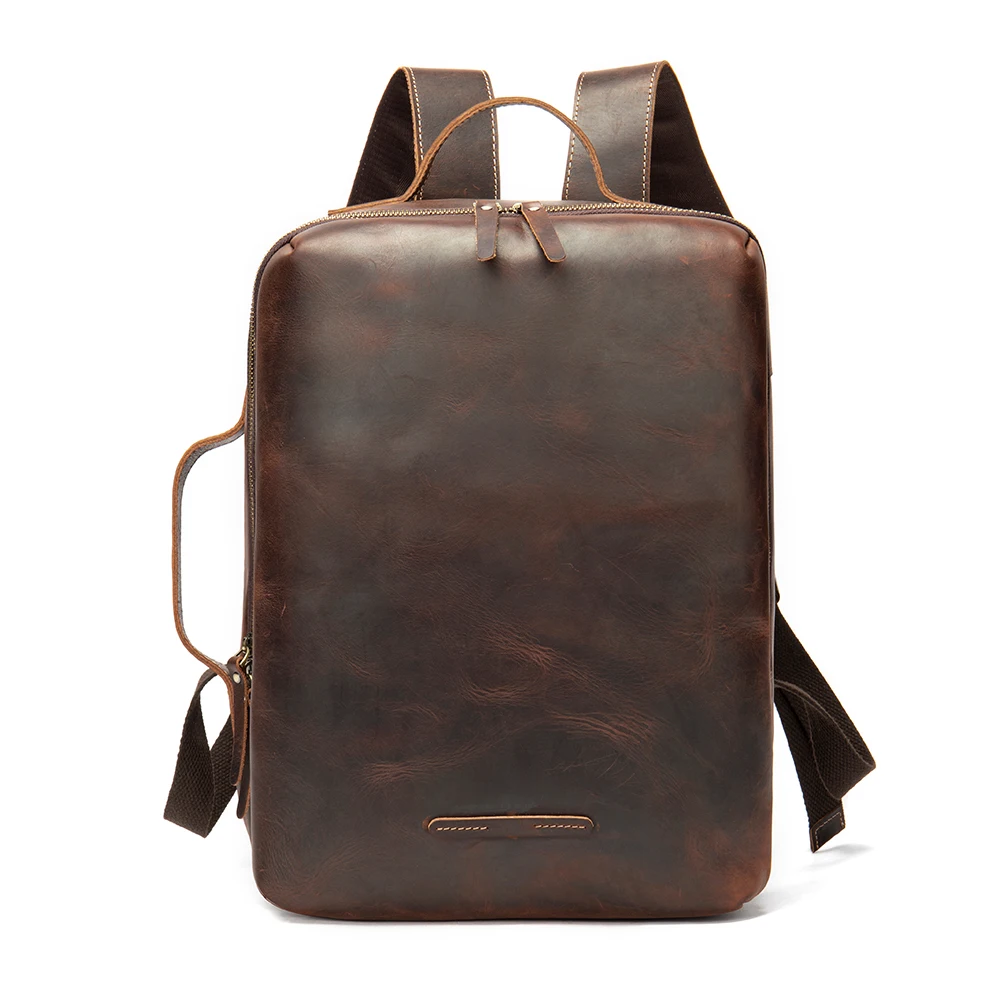
Ergonomics and Comfort: Supporting Heavy Loads
Even the most beautiful and durable leather backpack will go unused if it’s uncomfortable to wear. Quality rugged backpacks incorporate ergonomic design elements that make carrying heavy loads comfortable for extended periods.
Strap Design and Padding
Look for:
– Wide, padded shoulder straps (ideally 2-3 inches wide)
– Straps that curve to match shoulder contours
– Adjustable length to position the backpack properly on your back
– Reinforced attachment points that won’t tear under weight
– Quality stitching at all connection points
Back Panel Construction
The back panel greatly affects comfort during long wear:
– Padded design that provides lumbar support
– Breathable materials or design to reduce back sweat
– Structured support that keeps the backpack from sagging
– Contoured shape that hugs your back comfortably
Weight Distribution
How a backpack distributes weight determines comfort:
– Load positioned close to your back rather than hanging away
– Weight distribution across the entire back rather than concentrated points
– Strategic placement of heavier items near the center/top
– Compression straps to secure and stabilize loads
For those using their backpack daily, comfort features are just as important as durability. Many leather backpacks for daily use balance rugged construction with comfort-enhancing design elements.
Assessing Hardware Quality and Integration
Hardware elements are often the first points of failure in otherwise well-made backpacks. Quality hardware properly integrated into the leather construction ensures long-term reliability.
Zipper Assessment
Quality zippers should:
– Operate smoothly without catching
– Feature metal (not plastic) teeth
– Include leather pull tabs for easy gripping
– Be appropriately sized for their compartment
– Have YKK or similar quality branding
Buckles and Closures
Durable buckles and closures should be:
– Made from solid brass, copper, or stainless steel
– Heavy enough to suggest quality construction
– Free from sharp edges or poor casting marks
– Securely attached with reinforced leather tabs or rivets
– Functional without being overly complicated
Attachment Methods
How hardware attaches to the leather is crucial:
– Rivets should penetrate through layers and be properly peened (flattened)
– Stitched attachments should feature reinforcement
– No signs of glue as the primary attachment method
– Stress points should have additional reinforcement
– Metal D-rings and O-rings should be thick and solid
For examples of excellent hardware integration, examine our collection of leather rucksacks which feature traditional closure systems with modern reliability.
Weather Resistance and Protection Capabilities
While no leather backpack is completely waterproof without compromising its natural properties, quality leather offers inherent weather resistance that can be enhanced.
Natural Leather Properties
Quality full-grain leather offers:
– Natural water resistance that improves with proper conditioning
– The ability to repel light rain without damage
– Breathability that prevents internal moisture buildup
– A natural patina that develops from exposure to elements
Design Elements for Weather Protection
Rugged backpacks include design features that enhance protection:
– Overhanging flaps that direct water away from openings
– Minimal exposed stitching on upward-facing surfaces
– Interior linings that provide a secondary moisture barrier
– Strategic seam placement to minimize water intrusion
– Roll-top or flap closures rather than just zippers on top
Balancing Treatment and Natural Properties
The right care enhances weather resistance:
– Appropriate leather conditioning creates a water-resistant barrier
– Beeswax or similar natural treatments add protection
– Over-treating can damage leather’s natural properties
– Proper drying techniques after exposure prevent damage
Learning how to maintain a leather backpack properly is essential for maximizing both its weather resistance and overall lifespan.
Size Selection Guide for Different Uses
Choosing the right size backpack ensures it meets your needs without being cumbersome or insufficient.
| Size Category | Volume | Ideal Uses | Typical Contents | Considerations |
|---|---|---|---|---|
| Small | 10-20L (610-1220 cu in) | Daily essentials, minimalist carry | Wallet, phone, tablet, light jacket, small water bottle | Lighter weight, less strain, limited capacity |
| Medium | 20-30L (1220-1830 cu in) | Daily commuting, work carry | 15” laptop, documents, lunch, water bottle, extra layers | Versatile size for most daily needs |
| Large | 30L+ (1830+ cu in) | Travel, photography, extensive carry | Clothing, larger electronics, multiple books, camera gear | Heavier when full, more organizational needs |
When selecting size, consider:
– Your body frame (smaller frames may find large packs uncomfortable)
– Typical daily contents rather than occasional maximum needs
– The bulk of winter clothing if used year-round
– Device sizes (particularly laptop dimensions)
– Compartmentalization needs
For those needing substantial carrying capacity, our large leather backpack collection offers spacious options that maintain ergonomic comfort.
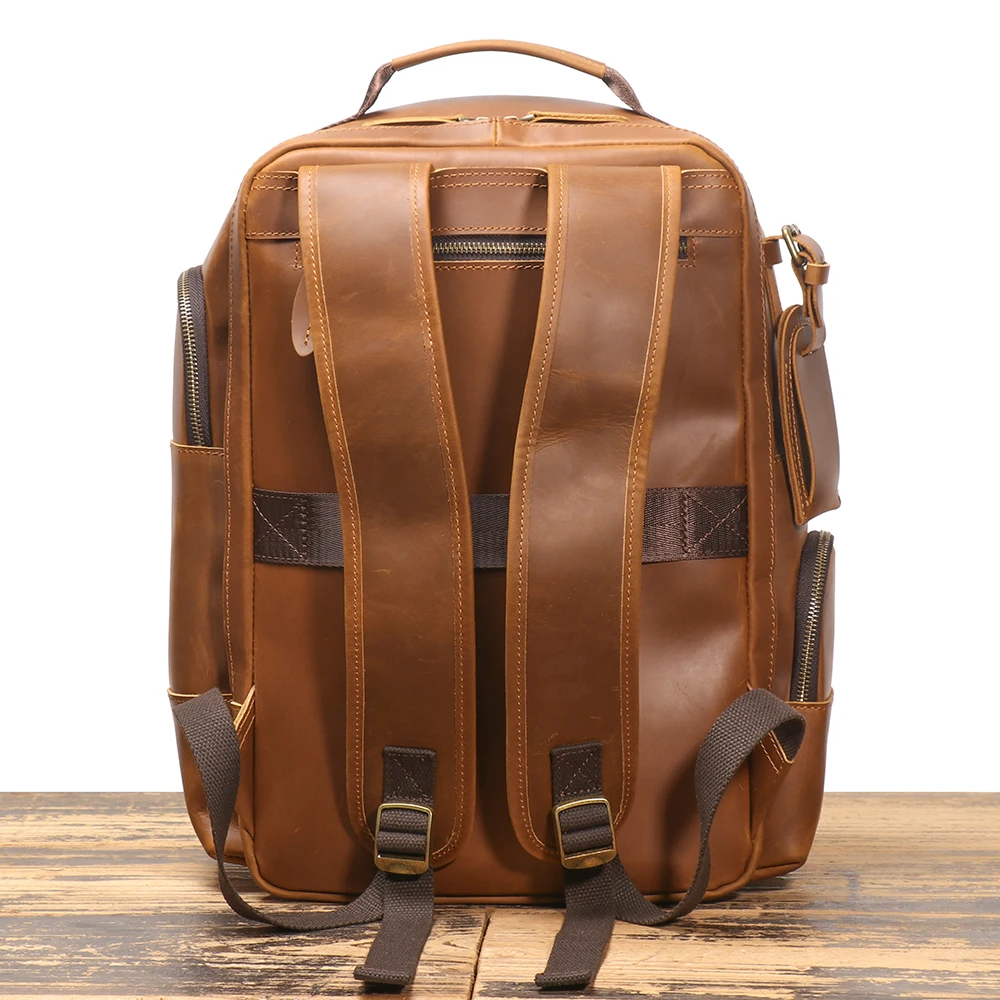
Investment Value and Long-term Cost Analysis
Quality leather backpacks represent an investment rather than just a purchase. Understanding their long-term value helps justify the initial premium.
Cost Breakdown Over Time
A quality full-grain leather backpack typically costs $200-500, while lower quality options might be $50-150. However:
- A $300 full-grain leather backpack lasting 20+ years costs $15/year
- A $75 synthetic backpack needing replacement every 2 years costs $37.50/year
- Low-quality “genuine” leather backpacks ($100-200) typically need replacement every 3-5 years
Value Appreciation Factors
Unlike most accessories, quality leather backpacks:
– Develop character and patina that enhances their appearance
– Can maintain or even increase resale value if well-maintained
– Reduce the environmental impact of frequent replacements
– Provide consistent functionality without degradation
Beyond Financial Value
The true value extends beyond cost:
– Eliminating the hassle of frequent replacements
– Consistent reliability without surprise failures
– The satisfaction of owning a quality item that improves with age
– Reduced environmental impact through longevity
Understanding the exceptional benefits of sturdy leather backpacks helps frame the purchase as a wise long-term investment rather than just an expense.
Proper Maintenance to Ensure Longevity
Even the highest quality leather backpack requires proper care to reach its potential lifespan and develop beautiful patina.
Regular Maintenance Schedule
Establish a simple routine:
1. Dust and wipe down your backpack weekly with a soft cloth
2. Condition the leather every 3-6 months depending on use
3. Clean thoroughly when visibly dirty or twice yearly
4. Inspect hardware and stitching quarterly for early intervention
Leather Cleaning and Conditioning
Proper techniques preserve leather quality:
1. Remove surface dirt with a slightly damp cloth
2. Use leather-specific cleaners for deeper cleaning
3. Apply quality leather conditioner appropriate for your leather type
4. Allow proper absorption and drying time
5. Buff gently after conditioning
Storage Practices
When not in use:
– Store in a breathable cloth bag, never plastic
– Keep away from direct sunlight and heat sources
– Maintain shape with light stuffing if stored long-term
– Ensure complete drying before storage
– Apply conditioner before extended storage periods
For detailed guidance, our articles on leather commuter backpack care tips and how to clean a leather backpack provide step-by-step instructions for extending your backpack’s lifespan.
Brand Reputation and Sourcing Ethics
The company behind your backpack matters as much as the physical product itself. Responsible manufacturers create superior products while minimizing environmental and social impact.
Quality Indicators in Manufacturing
Look for brands that:
– Have a established history in leatherworking
– Provide detailed information about their materials and processes
– Offer meaningful warranties (1+ years) that cover craftsmanship
– Show transparent production information
– Demonstrate expertise through educational content
Ethical Sourcing Considerations
Responsible leather sourcing includes:
– Using leather that’s a byproduct of the meat industry
– Employing vegetable-based or low-impact tanning processes
– Maintaining fair labor practices throughout production
– Minimizing waste through efficient cutting and manufacturing
– Creating products designed for long-term use rather than planned obsolescence
Environmental Impact
More sustainable leather practices include:
– Natural tanning methods that avoid toxic chemicals
– Local sourcing to reduce transportation emissions
– Water conservation and recycling in the tanning process
– Designing for longevity rather than fast fashion cycles
– Repair services that extend product lifespan
14 Inch Leather Laptop Backpack, Brown Leather Backpack, Men's Leather Backpack, Vintage Leather Backpack
Price range: $177.28 through $199.12 Select options This product has multiple variants. The options may be chosen on the product pageCarry On Leather Backpack, Roll Top Leather Backpack
Price range: $77.76 through $96.48 Select options This product has multiple variants. The options may be chosen on the product pageDesigner Men's Backpack, Men's Leather Laptop Backpack, Men's Leather Work Backpack
Price range: $158.04 through $160.04 Select options This product has multiple variants. The options may be chosen on the product pageDesigner Mini Backpack, Mini Leather Backpack, Small Leather Sling Backpack, Women's Leather Backpack
Price range: $95.76 through $98.80 Select options This product has multiple variants. The options may be chosen on the product pageDesigner Mini Backpack, Designer Women's Backpack, Mini Leather Backpack, Women's Leather Backpack
Price range: $135.92 through $137.64 Select options This product has multiple variants. The options may be chosen on the product page15 Inch Leather Laptop Backpack, Leather Briefcase Backpack
$332.96 Select options This product has multiple variants. The options may be chosen on the product page
Is a Rugged Leather Backpack Right for Your Lifestyle?
While quality leather backpacks offer numerous advantages, they’re not ideal for every situation. Consider these factors to determine if one aligns with your needs.
When Leather Backpacks Excel
Professional Settings: Leather backpacks offer sophistication that canvas or nylon can’t match, making them perfect for office environments.
Daily Urban Use: For city commuting, leather provides durability against constant friction and handling.
Travel: Quality leather withstands the rigors of travel while looking increasingly distinguished.
Investment Mindset: If you prefer buying quality items once rather than replacing cheaper alternatives repeatedly.
When to Consider Alternatives
Extreme Outdoor Activities: For hardcore hiking or extreme weather exposure, technical synthetic materials may be more appropriate.
Weight Concerns: Leather is naturally heavier than synthetic materials, which matters for those with physical limitations.
Strict Vegan Lifestyle: Those avoiding animal products will prefer canvas, synthetic, or plant-based leather alternatives.
Water-Intensive Activities: Despite good water resistance, activities involving submersion or constant heavy rain exposure might require fully waterproof materials.
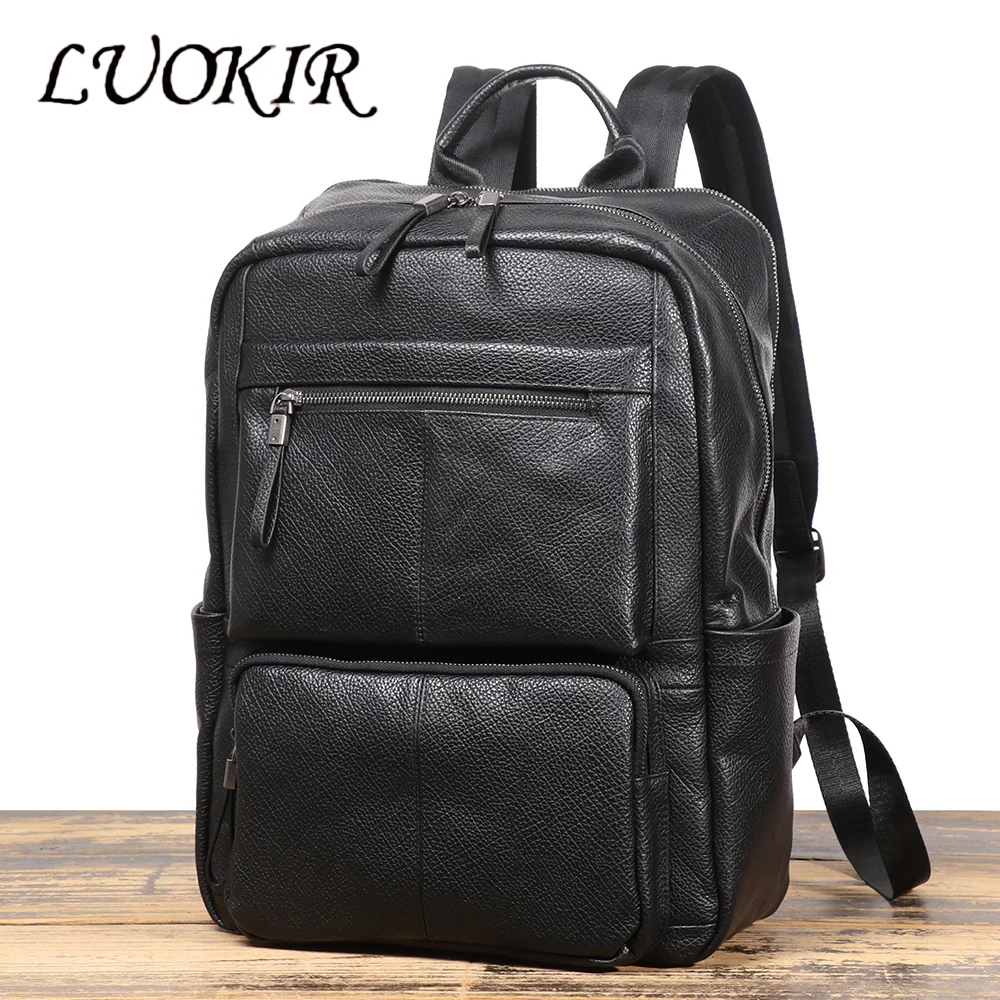
For those with varied needs, our men’s leather backpack collection offers options suited to different professional and casual contexts.
Shopping Checklist: What to Inspect Before Purchase
Whether shopping online or in person, use this checklist to thoroughly evaluate any leather backpack before purchasing:
Leather Quality: Examine the leather for natural grain patterns and appropriate thickness. Full-grain should show natural markings and variations.
Stitching: Check for tight, even stitches with no loose threads. Stress points should have reinforced or double stitching.
Hardware: Test all zippers, buckles, and clasps for smooth operation. Metal parts should feel substantial and be securely attached.
Interior Construction: Examine the lining for quality materials and secure attachment. Look for reinforced compartments and thoughtful organization.
Weight Distribution: Try the backpack on (or check return policies for online purchases). It should sit comfortably and distribute weight evenly.
Edge Finishing: Inspect edge finishing for smoothness and proper sealing. Rough or unfinished edges indicate poor craftsmanship.
Symmetry: Check that the backpack sits evenly and doesn’t lean or twist when set down.
Functional Details: Test accessibility of pockets and compartments; they should be usable without frustration.
Seams and Joints: Examine where different pieces come together for tight, precise construction.
Smell and Feel: Quality leather has a natural, pleasant smell and feels supple yet substantial.
Understanding the differences between types of closures in leather backpacks can help you select a design that meets your security and accessibility needs.
Common Questions About Rugged Leather Backpacks
How much should I expect to pay for a quality leather backpack?
For a genuine full-grain leather backpack with quality construction, expect to invest between $200-500. Lower-priced options (under $150) typically use lower-grade leather that won’t develop the same character or longevity. The price reflects not just the material but the craftsmanship and attention to detail.
Can leather backpacks be used in rainy conditions?
Quality leather backpacks can handle light rain, especially if properly conditioned. However, prolonged exposure to heavy rain isn’t ideal. Many users apply wax-based leather protectors to enhance water resistance. Always allow wet leather to dry naturally away from heat sources, then recondition afterward.
How long should a well-made leather backpack last?
With proper care, a full-grain leather backpack can last 15-25 years or longer. Many become family heirlooms, with leather developing a unique patina that tells the story of its journey. This longevity is why quality leather bags are considered investments rather than disposable accessories.
What’s the best way to break in a new leather backpack?
The best approach is natural use. Carry it regularly, allowing the leather to soften and conform to your body and contents. Avoid artificial breaking-in methods that can damage the leather. Condition it after the first few weeks of use to maintain suppleness as it adapts to your usage patterns.
For realistic expectations about durability and performance, our guide on long-lasting leather commuter bags provides practical insights from regular users.
Final Decision-Making Framework: Balancing Features and Budget
When making your final selection, consider these prioritization strategies:
Never Compromise On:
- Leather quality (always choose full-grain when possible)
- Stitching quality, especially at stress points
- Hardware durability, particularly zippers and strap attachments
Flexible Factors Based on Use:
- Size (match to your specific needs rather than going oversized)
- Number of compartments (more isn’t always better)
- Aesthetic details that don’t affect functionality
Investment Perspective:
Calculate cost-per-use rather than focusing solely on purchase price. A $300 backpack used daily for 15 years costs less than $0.06 per use—far less than replacing cheaper bags multiple times.
Finding Your Balance:
Start by identifying non-negotiable features for your specific needs, then determine where you’re willing to compromise. For some, additional organization is worth the extra cost; for others, leather quality and simplicity take precedence.
Our collection of vintage leather backpacks demonstrates how timeless design combined with quality materials creates pieces that balance aesthetics and functionality for years of reliable service.
By investing time in selecting the right rugged leather backpack, you’re choosing a daily companion that will serve you faithfully for years while developing character that mass-produced alternatives simply cannot match.

